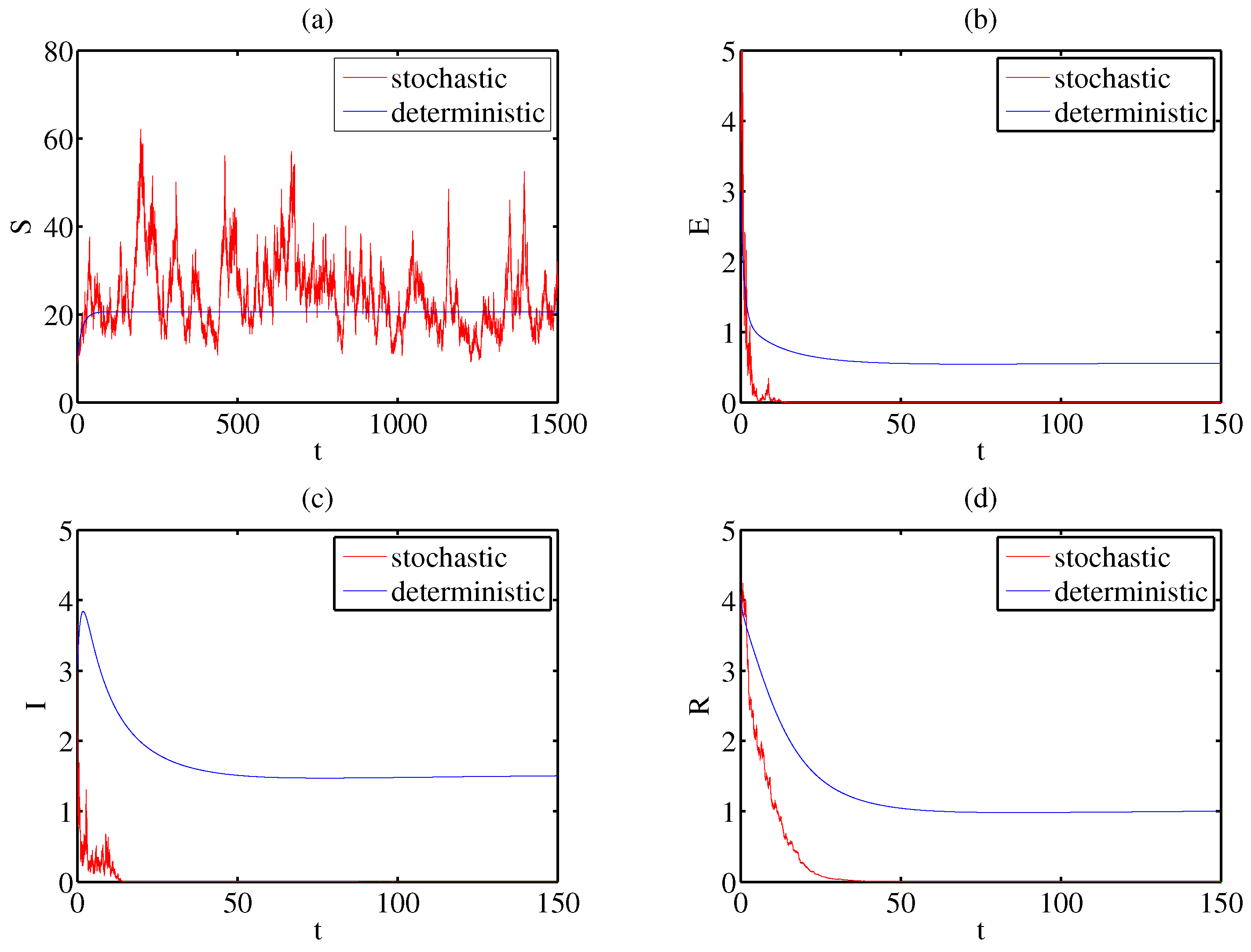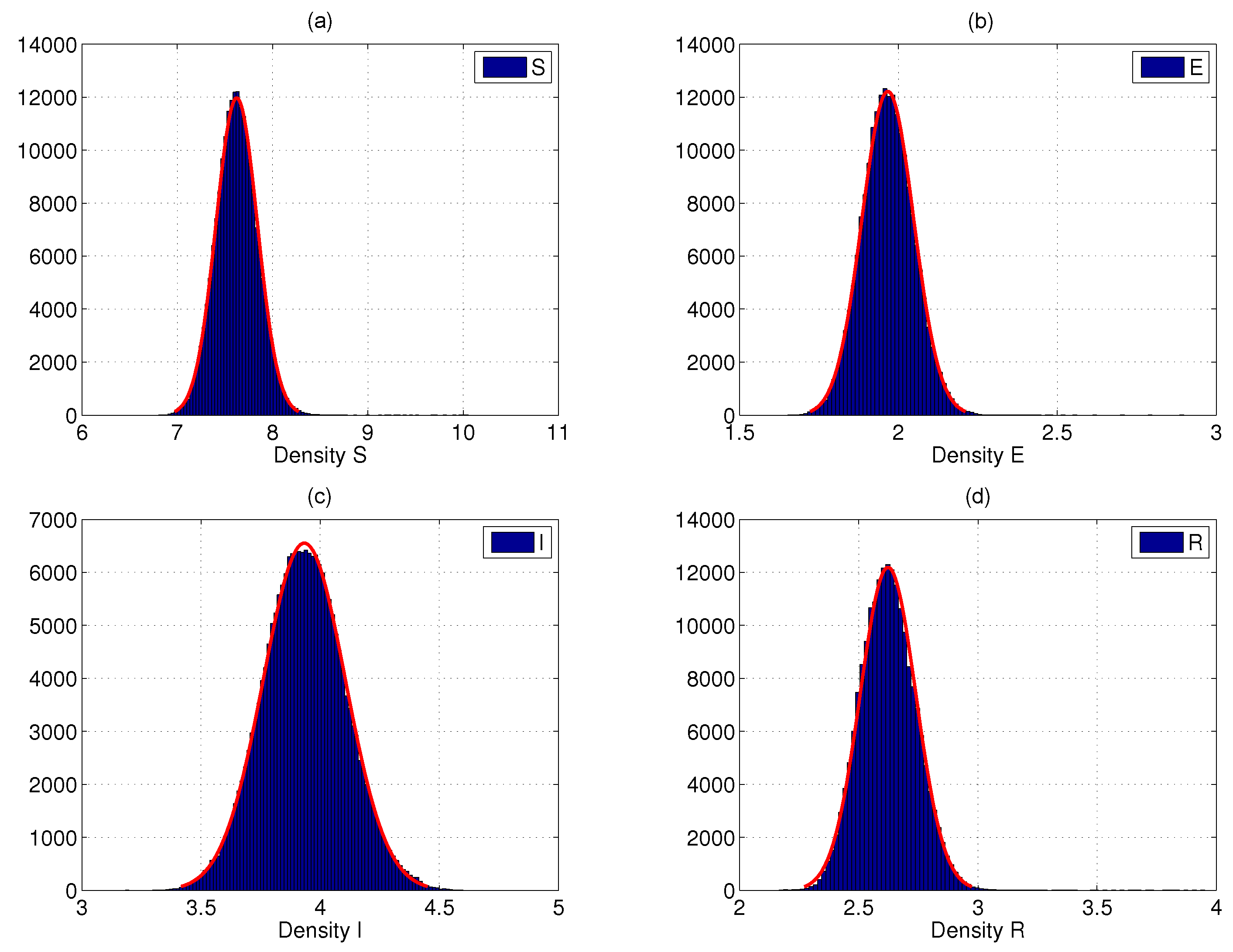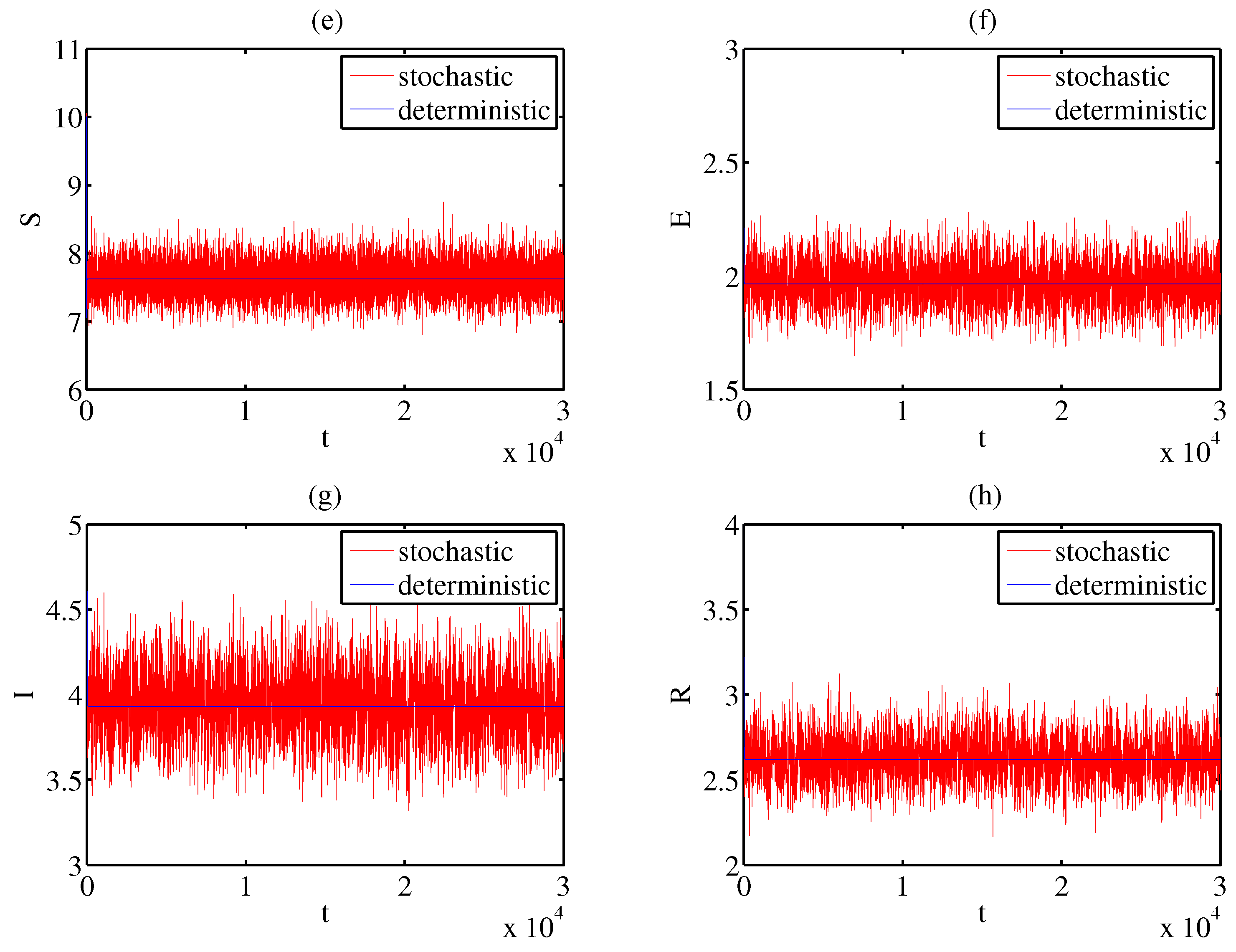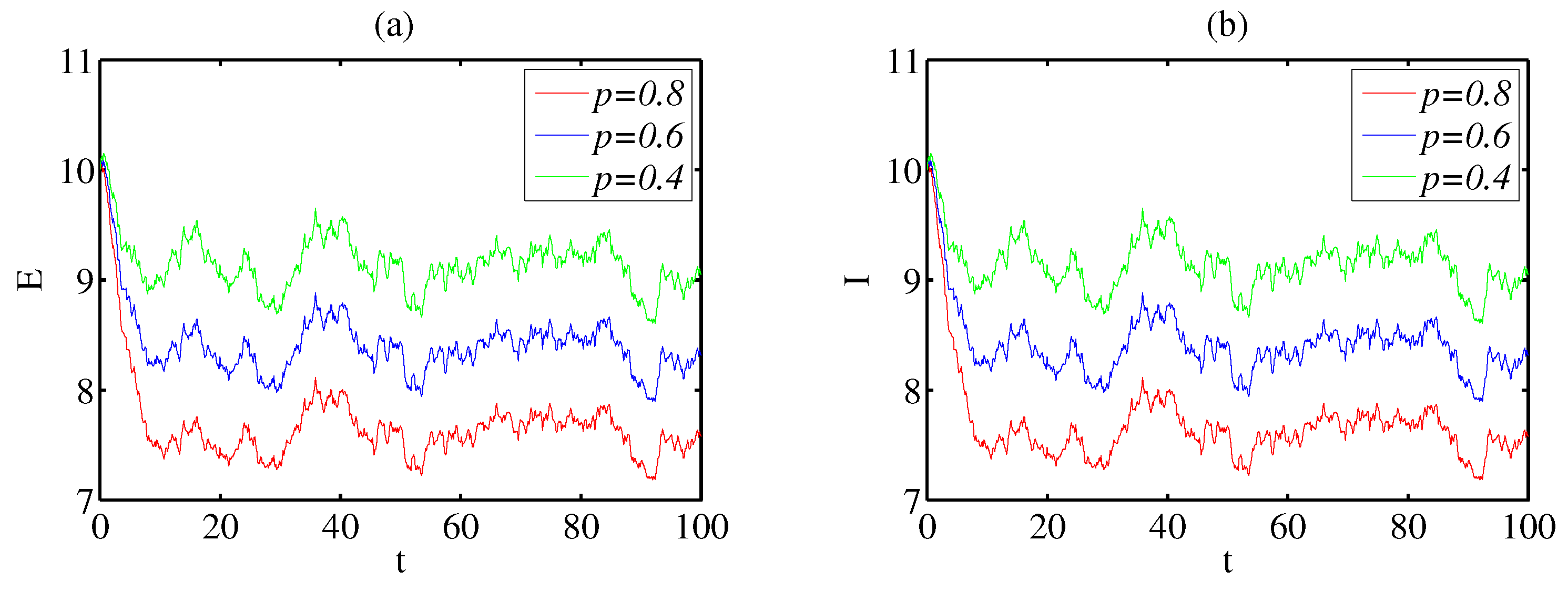Dynamics of a Stochastic SEIR Epidemic Model with Vertical Transmission and Standard Incidence
Abstract
1. Introduction
2. Existence of the Unique Global Positive Solution
3. Boundedness
4. Extinction
5. Stationary Distribution and Ergodicity
6. Numerical Simulations and Conclusions
- (1)
- Let = 0.1, = 1.2, = 1.2, and = 0.1. The other parameter values are as described above, calculated as , which fulfills the requirement of Theorem 3 and verifies the conclusion of Theorem 3. Figure 1 provides a better explanation.
- (2)
- (3)
- Due to the consideration of vertical transmission in this paper, the impact of parameter p on the system (2) is discussed. Figure 3 shows an inverse trend, where the larger the value of p, the smaller the value when it tends to stabilize. Therefore, by controlling the value of p, further exploration of the dynamic properties of disease transmission can be carried out in future work.
Author Contributions
Funding
Data Availability Statement
Conflicts of Interest
References
- Kermack, W.O.; McKendrick, A.G. A contributions to the mathematical theory of epidemics (Part I). Proc. R. Soc. A 1927, 115, 700–721. [Google Scholar]
- Wang, Y.; Meng, D. Quasi-Semilattices on Networks. Axioms 2023, 12, 943. [Google Scholar] [CrossRef]
- Gray, A.; Greenhalgh, D.; Hu, L.; Mao, X.; Pan, J. A stochastic differential equation SIS epidemic model. SIAM J. Appl. Math. 2011, 71, 876–902. [Google Scholar] [CrossRef]
- d’Onofrio, A. On pulse vaccination strategy in the SIR epidemic model with vertical transmission. Appl. Math. Lett. 2005, 18, 729–732. [Google Scholar] [CrossRef]
- Zhao, Y.; Jiang, D. The threshold of a stochastic SIS epidemic model with vaccination. Appl. Math. Comput. 2014, 243, 718–727. [Google Scholar] [CrossRef]
- Meng, X.; Zhao, S.; Feng, T.; Zhang, T. Dynamics of a novel nonlinear stochastic SIS epidemic model with double epidemic hypothesis. J. Math. Anal. Appl. 2016, 433, 227–242. [Google Scholar] [CrossRef]
- Wang, H.; Zhang, G.; Chen, T.; Li, Z. Threshold Analysis of a Stochastic SIRS Epidemic Model with Logistic Birth and Nonlinear Incidence. Mathematics 2023, 11, 1737. [Google Scholar] [CrossRef]
- McCluskey, C.C. Complete global stability for an SIR epidemic model with delay-distributed or discrete. Nonlinear Anal. Real. 2010, 11, 55–59. [Google Scholar] [CrossRef]
- Meng, X.; Chen, L. The dynamics of a new SIR epidemic model concerning pulse vaccination strategy. Appl. Math. Comput. 2008, 197, 582–597. [Google Scholar] [CrossRef]
- Yang, Q.; Jiang, D.; Shi, N.; Ji, C. The ergodicity and extinction of stochastically perturbed SIR and SEIR epidemic models with saturated incidence. J. Math. Anal. Appl. 2012, 388, 248–271. [Google Scholar] [CrossRef]
- Lahrouza, A.; Omaria, L.; Kiouachb, D.; Belmaatic, A. Complete global stability for an SIRS epidemic model with generalized non-linear incidence and vaccination. Appl. Math. Comput. 2012, 218, 6519–6525. [Google Scholar] [CrossRef]
- Li, M.; Muldowney, J. Global stability for the SEIR model in epidemiology. Math. Biosci. 1995, 125, 155–164. [Google Scholar] [CrossRef] [PubMed]
- Gao, S.; Chen, L.; Teng, Z. Pulse vaccination of an SEIR epidemic model with time delay. Nonlinear Anal. Real. 2008, 9, 599–607. [Google Scholar] [CrossRef]
- Meng, X.; Wu, Z.; Zhang, T. The dynamics and therapeutic strategies of a SEIS epidemic model. Int. J. Biomath. 2013, 6, 1350029. [Google Scholar] [CrossRef]
- Li, M.; Smith, H.; Wang, L. Global dynamics of an SEIR epidemic model with vertical transmission. SIAM J. Appl. Math. 2001, 62, 58–69. [Google Scholar] [CrossRef]
- Busenberg, B.S.; Cooke, K. Vertically Transmitted Diseases; Springer: Berlin/Heidelberg, Germany, 1993. [Google Scholar]
- Gao, S.; Xie, D.; Chen, L. Pulse vaccination strategy in a delayed SIR epidemic model with vertical transmission. Discrete Cont. Dyn. B 2006, 7, 77–86. [Google Scholar] [CrossRef]
- Qi, L.; Cui, J. The stability of an SEIRS model with nonlinear incidence, vertical transmission and time delay. Appl. Math. Comput. 2013, 221, 360–366. [Google Scholar] [CrossRef]
- Qi, H.; Meng, X. Mathematical modeling, analysis and numerical simulation of HIV: The influenceof stochastic environmental fluctuations on dynamics. Math. Comput. Simul. 2021, 187, 700–719. [Google Scholar] [CrossRef]
- Leng, X.; Khan, A.; Din, A. Probability Analysis of a Stochastic Non-Autonomous SIQRC Model with Inference. Mathematics 2023, 11, 1806. [Google Scholar] [CrossRef]
- Zhang, Y.; Meng, X. Dynamics Analysis of a Predator–Prey Model with Hunting Cooperative and Nonlinear Stochastic Disturbance. Mathematics 2022, 10, 2890. [Google Scholar] [CrossRef]
- Zhou, Y.; Yuan, S.; Zhao, D. Threshold behavior of a stochastic SIS model with levy jumps. Appl. Math. Comput. 2016, 275, 255–267. [Google Scholar]
- Bai, Z.; Zhou, Y. Existence of two periodic solutions for a non-autonomous SIR epidemic model. Appl. Math. Model. 2011, 35, 382–391. [Google Scholar] [CrossRef]
- Liu, M.; Wang, K. Persistence and extinction in stochastic non-autonomous logistic systems. J. Math. Anal. Appl. 2011, 375, 443–457. [Google Scholar] [CrossRef]
- Li, F.; Zhang, S.; Meng, X. Dynamics analysis and numerical simulations of a delayed stochastic epidemic model subject to a general response function. J. Comput. Appl. Math. 2019, 38, 95. [Google Scholar] [CrossRef]
- Mao, X. Stochastic Differential Equations and Their Applications; Horwood: Chichester, UK, 1997. [Google Scholar]
- Mao, X.; Marion, G.; Renshaw, E. Environmental brownian noise suppresses explosions in population dynamics. Stoch. Proc. Appl. 2002, 97, 95–110. [Google Scholar] [CrossRef]
- Zhao, D. Study on the threshold of a stochastic SIR epidemic model and its extensions. Commun. Nonlinear Sci. 2016, 38, 172–177. [Google Scholar] [CrossRef]
- Jin, X.; Jia, J. Qualitative study of a stochastic SIRS epidemic model with information intervention. Phys. A Stat. Mech. Its Appl. 2020, 547, 123866. [Google Scholar] [CrossRef]
- Khasminskii, R. Stochastic Stability of Differential Equations; Springer: Berlin/Heidelberg, Germany, 2011; Volume 66. [Google Scholar]




| Parameters | Biological Significance |
|---|---|
| The recruitment rate of susceptible individuals corresponding to immigration. | |
| The disease transmission rate. | |
| b | The birth rate. |
| d | The natural mortality rate. |
| The population output rate that corresponds to emigration. | |
| The rate at which those who are exposed become infectious. | |
| The mortality rate associated with the disease. | |
| The rate of recovery for those who carry the infection. | |
| p (0 < p < 1) | The proportion of exposed individuals in babies of exposed or infected individuals. |
| q = | The proportion of susceptible individuals in babies of exposed or infected individuals. |
Disclaimer/Publisher’s Note: The statements, opinions and data contained in all publications are solely those of the individual author(s) and contributor(s) and not of MDPI and/or the editor(s). MDPI and/or the editor(s) disclaim responsibility for any injury to people or property resulting from any ideas, methods, instructions or products referred to in the content. |
© 2024 by the authors. Licensee MDPI, Basel, Switzerland. This article is an open access article distributed under the terms and conditions of the Creative Commons Attribution (CC BY) license (https://creativecommons.org/licenses/by/4.0/).
Share and Cite
Li, R.; Guo, X. Dynamics of a Stochastic SEIR Epidemic Model with Vertical Transmission and Standard Incidence. Mathematics 2024, 12, 359. https://doi.org/10.3390/math12030359
Li R, Guo X. Dynamics of a Stochastic SEIR Epidemic Model with Vertical Transmission and Standard Incidence. Mathematics. 2024; 12(3):359. https://doi.org/10.3390/math12030359
Chicago/Turabian StyleLi, Ruichao, and Xiurong Guo. 2024. "Dynamics of a Stochastic SEIR Epidemic Model with Vertical Transmission and Standard Incidence" Mathematics 12, no. 3: 359. https://doi.org/10.3390/math12030359
APA StyleLi, R., & Guo, X. (2024). Dynamics of a Stochastic SEIR Epidemic Model with Vertical Transmission and Standard Incidence. Mathematics, 12(3), 359. https://doi.org/10.3390/math12030359





